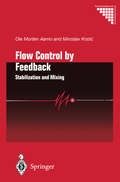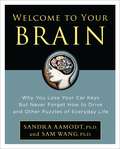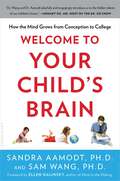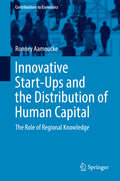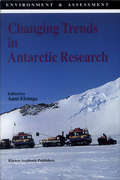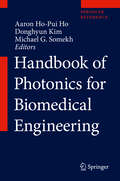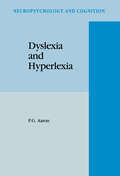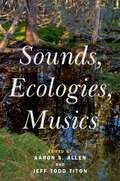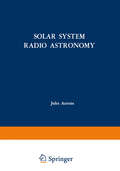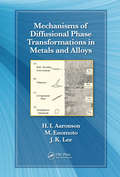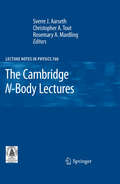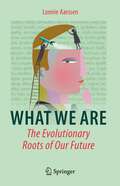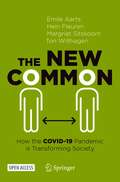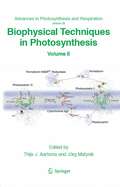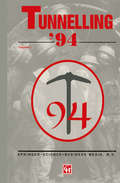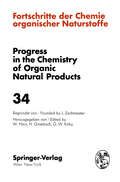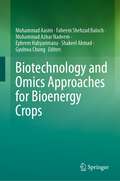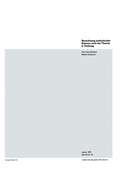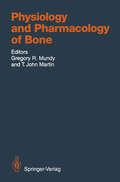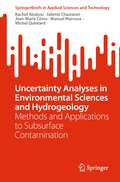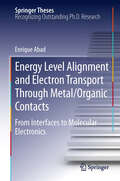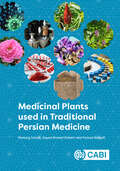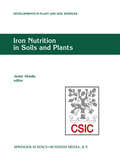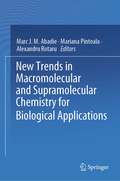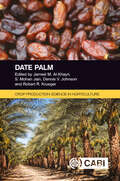- Table View
- List View
Flow Control by Feedback: Stabilization and Mixing (Communications and Control Engineering)
by Ole Morten Aamo Miroslav KrsticThis accessible book pioneers feedback concepts for control mixing. It reviews research results appearing over the last decade, and contains control designs for stabilization of channel, pipe and bluff body flows, as well as control designs for the opposite problem of mixing enhancement.
Welcome to Your Brain: Why You Lose Your Car Keys but Never Forget How to Drive and Other Puzzles of Everyday Life
by Sandra Aamodt Sam WangDoes drinking really kill brain cells? Does listening to Mozart make your baby smarter? For all the mileage we've gotten from our own brains, most of us have essentially no idea how they work. We're easily susceptible to myths (like the "fact" that we use only 10% of our brains) and misconceptions (like the ones perpetrated by most Hollywood movies), probably because we've never known where to turn for the truth.But neurologists Sandra Aamodt and Sam Wang are glad to help. In this funny, accessible book, we get a guided tour of our own minds, what they're made of, how they work, and how they can go wrong. Along the way, we get a host of diagrams, quizzes, and "cocktail party tips" that shed light on the questions we nag each other about. (Can a head injury make you forget your own name? Are dolphins smarter than chimpanzees?)Fun and surprisingly engrossing, Welcome to Your Brain shows you how your brain works, and how you can make it work better.
Welcome to Your Child's Brain: How the Mind Grows from Conception to College
by Sandra Aamodt Sam WangHow children think is one of the most enduring mysteries--and difficulties--of parenthood. The marketplace is full of gadgets and tools that claim to make your child smarter, happier, or learn languages faster, all built on the premise that manufacturers know something about your child's brain that you don't. These products are easy to sell, because good information about how children's minds really work is hard to come by.In their new book, neuroscientists Sandra Aamodt and Sam Wang separate fact from fiction about the inner workings of young minds. Martialing results from new studies and classic research, Aamodt and Wang provide the most complete answers out there on this subject. It liberates readers from superstitions and speculation, such as Freud's idea that all relationships are modeled on one's mother, or that it's not safe to eat sushi while pregnant. And it will reveal new truths about everything from how to make your baby sleep, to why we love to snuggle, to how children learn, forget, play, talk, walk, and feel.Welcome to Your Child's Brain is eye-opening and necessary, soon to become a staple for parents and children alike.
Innovative Start-Ups and the Distribution of Human Capital: The Role of Regional Knowledge (Contributions to Economics)
by Ronney AamouckeThis book contributes to our understanding of the reasons for the uneven geographic emergence and distribution of innovative start-ups and human capital, analyzing the role of the regional knowledge base and specifically academic knowledge. Using extensive datasets from West German regions and advanced econometric tools, it confirms a strong relationship between the presence of higher education institutions and the emergence of innovative start-ups. It also shows that the influence increases in direct relation with the innovativeness of the respective start-up, and that certain fields of knowledge are more influential than others in fostering innovative start-ups. In a second step, the multidimensional concept of quality of life is used to explain the geography of human capital across West German regions. Based on these empirical findings, the book shares valuable insights for higher education and regional development policy.
Changing Trends in Antarctic Research (Environment & Assessment #3)
by AantElzingaThe core of this volume is a report from a symposium held at the University of Goteborg in the Fall of 1991. It deals with the interplay of science and politics and how^ such interplay affects research agendas. The focus is on polar research in Antarctica, a continent that has been much in the news during the past couple of years. It gives me particular pleasure to thank all the speakers who took part in the program. All of them have many commitments and involvements in international polar research and the protection of Antarctica for its scientific and aesthetic values. The fact that such a distinguished group has been willing to come to Goteborg, to my mind attests to the importance and timeliness of our topic and the relevance of epistemological and policy issues in this field. A presentation of each speaker and author is made within the relevant chapters in the text. My interest in the Antarctic has its origins in discussions with Anders Karlqvist, the Director of the Swedish Polar Research Secretariate at the Royal Academy of Science in Stockholm. Anders and I had worked together in the early 80's in a program on Technology and Culture, among other at the Research Policy Institute in Lund. At the time he was with the Swedish Council for Planning and Coordination of Research (FRN), its Committee for Future Oriented Research headed by Torsten Hagerstrand.
Handbook of Photonics for Biomedical Engineering
by Aaron Ho-Pui Ho, Donghyun Kim and Michael G. SomekhDyslexia and Hyperlexia: Diagnosis and Management of Developmental Reading Disabilities (Neuropsychology and Cognition #1)
by P. G. AaronEven though I had been studying reading problems in children for a number of years as a means of understanding cognitive processes, I became deeply committed to the study of developmental dyslexia after my encounter with S. H. , a dyslexic college student. Until then, dyslexia to me remained an interesting phenomenon but somewhat removed from the mainstream of my research interests. The facts that, in spite of his superior IQ, S. H. could read no better than a child in the fifth grade and misspelled even common words such as was and here, however, took me by surprise and made me appreciate the intriguing and challenging nature of developmental dyslexia. This led to a series of studies of college students with reading disability, a group that is relatively unexplored. The general plan of these investigations was to study a small number of disabled readers at any given time, rather intensively. Even though this approach limits the generalizability of the research findings, it lays bare some of the most interesting facts about dyslexia which are obscured in large-scale statistical studies. These studies have now extended well over a decade and are still continuing. As soon as these studies were started, it became obvious that not all reading-disabled college students are alike and that disabled readers could be classified into three broad categories: those with poor decod ing skill, those with poor comprehension ability, and those with a combination of these two deficits.
Sounds, Ecologies, Musics
by Aaron S. Allen and Jeff Todd TitonSounds, Ecologies, Musics poses exciting challenges and provides fresh opportunities for scholars, scientists, environmental activists, musicians, and listeners to consider music and sound from ecological standpoints. Authors in Part I examine the natural and built environment and how music and sound are woven into it, how the environment enables music and sound, and how the natural and cultural production of music and sound in turn impact the environment. In Part II, contributors consider music and sound in relation to ecological knowledges that appear to conflict with, yet may be viewed as complementary to, Western science: traditional and Indigenous ecological and environmental knowledges. Part III features multidisciplinary and interdisciplinary approaches by scholars, scientists, and practitioners who probe the ecological imaginary regarding the complex ideas and contested keywords that characterize ecomusicology: sound, music, culture, society, environment, and nature. A common theme across the book is the idea of diverse ecologies. Once confined to the natural sciences, the word "ecology" is common today in the social sciences, humanities, and arts - yet its diverse uses have become imprecise and confusing. Engaging the conflicting and complementary meanings of "ecology" requires embracing a both/and approach. Diverse ecologies are illustrated in the methodological, terminological, and topical variety of the chapters as well as the contributors' choice of sources and their disciplinary backgrounds. In times of mounting human and planetary crises, Sounds, Ecologies, Musics challenges disciplinarity and broadens the interdisciplinary field of ecomusicologies. These theoretical and practical studies expand sonic, scholarly, and political activism from the diversity-equity-inclusion agenda of social justice to embrace the more diverse and inclusive agenda of ecocentric ecojustice.
Solar System Radio Astronomy: Lectures presented at the NATO Advanced Study Institute of the National Observatory of Athens: Cape Sounion August 2–15, 1964
by Jules AaronsThe Ionospheric Institute of the National Observatory of Athens has had two interests in recent years: the study of the ionosphere and the study of the sun. In our previous Advanced Study Institutes in 1960, 1961, and 1962, we have em phasized the ionosphere. For the Advanced Study Institute of 1964, however, we invited Dr. Jules Aarons of the Air Force Cambridge Research Laboratories to collaborate in preparing and directing a program of studies of the sun, the moon, the planets, and the interplanetary medium. The lectures of this Advanced Study Institute form essentially an advanced course in radio astronomy. Without being a textbook on the matter, we feel that the present book can be considered as an excellent reference for those students starting their research work in the field of solar system radio astronomy. All lecturers tried to present their subjects in a simple form based upon their exten sive personal experience, but without emphasizing their personal research. We must recognize that it was an excellent achievement for them to keep their text exactly at the level indicated by the Program Director, and outlined by the gen eral program of Advanced Study Institutes of NATO. We are deeply grateful to all the invited scientists for their outstanding contributions in lecturing on their subjects in a clear and authoritative manner. The Scientific Affairs Division of NATO, in its aid to basic research, spon sors various programs. Among them is the Program of Advanced Study Institutes.
Mechanisms of Diffusional Phase Transformations in Metals and Alloys
by Hubert I. AaronsonDeveloped by the late metallurgy professor and master experimentalist Hubert I. Aaronson, this collection of lecture notes details the fundamental principles of phase transformations in metals and alloys upon which steel and other metals industries are based. Mechanisms of Diffusional Phase Transformations in Metals and Alloys is devoted to solid-s
The Cambridge N-Body Lectures (Lecture Notes in Physics #760)
by Sverre Aarseth Christopher Tout Rosemary MardlingPublished under the auspices of the Royal Astronomical Society, this volume contains a set of extensive school tested lectures, with the aim to give a coherent and thorough background knowledge of the subject and to introduce the latest developments in N-body computational astrophysics. The topics cover a wide range from the classical few-body problem with discussions of resonance, chaos and stability to realistic modelling of star clusters as well as descriptions of codes, algorithms and special hardware for N-body simulations. This collection of topics, related to the gravitational N-body problem, will prove useful to both students and researchers in years to come.1) Published under the auspices of the Royal Astronomical Society.
What We Are: The Evolutionary Roots of Our Future
by Lonnie AarssenOther animals are driven to spend essentially their whole lives just trying to get fed, stay alive, and get laid. That’s about it. The same was true for our proto-human ancestors. And modern humans of course also require a Survival Drive and a Sex Drive in order to leave descendants. But today we spend most of our lives mainly just trying to convince ourselves that our existence is not absurd. In What We Are, Queen’s University biologist, Lonnie Aarssen, traces how our biocultural evolution has shaped Homo sapiens into the only creature that refuses to be what it is — the only creature preoccupied with a deeply ingrained, and absurd sentiment: I have a distinct ‘mental life’—an ‘inner self’—that exists separately and apart from ‘material life’, and so, unlike the latter, need not come to an end. This delusion conceivably gave our distant ancestors some wishful thinking for finding some measure of relief from the terrifying, uniquely human knowledge of the eventual loss of corporeal survival. But this came with an impulsive, nagging doubt — an obsessive underlying uncertainty: ‘self-impermanence anxiety’. Biocultural evolution, however, was not finished. It also gave us two additional, uniquely human, primal drives, both serving to help quell the burden of this anxiety. Legacy Drive generates delusional cultural domains for ‘extension’ of self; and Leisure Drive generates pleasurable cultural domains for distraction – ‘escape’ – from self. Legacy Drive and Leisure Drive, Aarssen argues, represent two of the most profound consequences of human cognitive and cultural evolution. What We Are advances propositions regarding how a visceral susceptibility to self-impermanence anxiety has — paradoxically — played a pivotal role in rewarding the reproductive success of our ancestors, and has thus been a driving force in shaping fundamental motivations and cultural norms of modern humans. More than any other milestone in the evolution of human minds, self-impermanence anxiety, and its mitigating Drives for Legacy and Leisure, account for not just the advance of civilization over the past many thousands of years, but also now, its impending collapse. Effective management of this crisis, Aarssen insists, will require a deeper and more broadly public understanding of its Darwinian evolutionary roots — as laid out in What We Are.
The New Common: How the COVID-19 Pandemic is Transforming Society
by Emile Aarts Hein Fleuren Margriet Sitskoorn Ton WilthagenThis open access book presents the scientific views of some fifty experts on how they believe the COVID-19 pandemic is currently affecting society, and how it will continue to do so in the years to come. Using the concept of a “common” (in the sense of common values, common places, common goods, and common sense), they elaborate on the transition from an Old Common to a New Common. In carefully crafted chapters, the authors address expected shifts in major fields like health, education, finance, business, work, and citizenship, applying concepts from law, psychology, economics, sociology, religious studies, and computer science to do so. Many of the authors anticipate an acceleration of the digital transformation in the forthcoming years, but at the same time, they argue that a successful shift to a new common can only be achieved by re-evaluating life on our planet, strengthening resilience at an individual level, and assuming more responsibility at a societal level.
Biophysical Techniques in Photosynthesis: Volume II (Advances in Photosynthesis and Respiration #26)
by Thijs Aartsma Jörg MatysikSince the first volume on Biophysical Techniques in Photosynthesis Research, published in 1996, new experimental techniques and methods have been devised at a rapid pace. The present book is a sequel which complements the publication of the first volume by providing a comprehensive overview of the most important new techniques developed over the past ten years, especially those that are relevant for research on the mechanism and fundamental aspects of photosynthesis.
Tunnelling ’94: Papers presented at the seventh international symposium, ‘Tunnelling’94’
by Vidar Aarvold I. L. Chudleigh N. S. Webb G. A. Featherstone Manfred Bandmann H. Ramisch Uwe Beckmann B. J. Cole H. J. Lees Walter Dietz D. F. Fawcett P. J. Chapman D. A. Barratt M. P. O’Reilly John Temporal Jon Baston-Pitt F. J. Fredriksen Roald Aabøe G. J. Hasle D. A. Hobson D. C. Gilchrist Sandor Jancsecz Walter Steiner J. P. Farrow P. M. Claye R. B. Warren M. A. Ginary R. Matthews H. Kruizenga C. R. Weeks T. R. Winterton Y. Leblais L. Leblond Yannis Malios J. Y. Peron P. Marcheselli P. Catling J. Scholey A. D. Murray Bruno Marrai P. G. Davies Guilherme Tibau Erik Gutenwik Maurício Santana Pierre Jean Pellegri R. J. Fowell G. Richardson M. J. Gollick J. G. Beatty R. J. Ganey J. E. Killingsworth L. J. Arthur A. W. Darby B. Rafoneke Graham Daws Dan MacDonald Nicola Innaurato Renato Mancini Enrico Rondena Attilio Zaninetti A. W. Coutts H. R. Davies R. S. Curtis A. P. Finch R. P. Lovat A. P. Deane K. T. Burgess M. C. Knights M. A. Oswell I. W. Farmer B. W. Mak Daniel Morfeldt C. J. Martin G. Pakes Sigurdur Finnsson H. A. Janzon C. Laughton Y. Abd Al-Jalil R. Remington H. P. Caspe A. Y. Kim L. J. Bergen J. R. Araujo Klaus Axhausen J. E. Hellings R. J. Mair D. I. Harris J. P. Love D. Blakey B. M. New K. H. Bowers P. P. Nelson Richard Harpf C. KettleIt is now more than twenty years since a proposal was first mooted to hold an international tunnelling symposium in Britain. At the time of the first symposium, held in London in 1976, the Channel Tunnel pro ject had just been shelved. Last weekend a charity walk was held in the finished tunnel, which will be open for business later in the year. Tunnels have figured prominently, and at times spectacularly, in the development of national and international links and it is hoped that such links gather pace in the future. It is particularly pleasing that Alastair Biggart of Storebrelt has agreed to deliver the twenty-sixth Sir Julius Wernher Memorial Lecture of the Institution of Mining and Metallurgy, entitled 'The changing face of tunnelling', at the start of this event. * Although almost every edition of the technical journals on tunnelling reports another £1 billion scheme somewhere in the world, it would be unfair of me to suggest that tunnelling is restricted to these prestigious schemes for major transport links. Much of the work that makes mod ern life possible receives hardly a mention outside the technical press and one suspects that society at large applies the 'out of sight, out of mind' attitude even more readily to underground construction than it does to other forms of engineering. Clearly, there is a contiiming need to improve the capacity and performance of our infrastructure, while hav ing a careful regard for the environment.
Fortschritte der Chemie Organischer Naturstoffe / Progress in the Chemistry of Organic Natural Products (Fortschritte der Chemie organischer Naturstoffe Progress in the Chemistry of Organic Natural Products #34)
by A. J. Aasen D. P. Chakraborty C. R. Enzell D. Gross J. Jacob K. H. Overton D. J. Picken A. R. Pinder W. Voelter I. WahlbergBiotechnology and Omics Approaches for Bioenergy Crops
by Muhammad Aasim Faheem Shehzad Baloch Muhammad Azhar Nadeem Ephrem Habyarimana Shakeel Ahmad Gyuhwa ChungThis edited book summarizes the efforts made to develop sustainable bioenergy production through different generations. The topics included in the book cover information about different bioenergy crops, their classification and use as biofuel, agronomic practices to improve biomass yield, classic breeding techniques, genetic diversity, current status and future perspective of bioenergy crops in the omics era. It also discusses application of modern biotechnological and molecular biotechnological techniques for the improvement of bioenergy crops this having enhanced biomass and plant based products. The book explores growing biofuel crops and their impact on environment, bioethics and biosafety issues related to the modern approaches. Another important aspect is the incorporation of nanotechnology for bioenergy crops and biofuel production. All book chapters are contributed renowned researchers in their respective field. This is a unique book covering the bioeneragy crops in the modern omics era. The book is useful for the researchers and post-graduate students to guide them in the field of bioenergy crops.
Berechnung unelastischer Rahmen nach der Theorie 2. Ordnung (Institut für Baustatik und Konstruktion #45)
by K. Aas-Jakobsen GrenacherPhysiology and Pharmacology of Bone (Handbook of Experimental Pharmacology #107)
by A.-B. Abou-Samra D. C. Anderson H. C. Anderson R. Baron W. Born F. R. Bringhurst E. Canalis M. Centrella M. Chakraborty D. Chatterjee P. D. Delmas J. A. Eisman E. F. Eriksen D. M. Findlay J. A. Fischer H. Fleisch J. K. Heath W. Horne H. Jüppner M. Kassem H. M. Kronenberg L. E. Lanyon A. Lomri L. Malaval T. J. Martin T. L. McCarthy F. Melsen D. C. Morris L. Mosekilde G. R. Mundy K. W. Ng S. Nussbaum A. M. Parfitt M. Peacock J.T.Jr. Potts L. G. Raisz J. H. Ravesloot V. Rosen G. Segre K. C. Shoukri A. Vesterby J. M. WozneyThe authors, all accomplished and world-renowned experts in their topic areas, have provided controversial and up-to-date accounts of the current status of research in calcium and bone metabolism by reviewing major areas of basic science which have an impact on the understanding of bone diseases and related disorders.
Uncertainty Analyses in Environmental Sciences and Hydrogeology: Methods and Applications to Subsurface Contamination (SpringerBriefs in Applied Sciences and Technology)
by Rachid Ababou Juliette Chastanet Jean-Marie Côme Manuel Marcoux Michel QuintardThis book highlights several methods and quantitative implementations of both probabilistic and fuzzy-based approaches to uncertainty quantification and uncertainty propagation through environmental subsurface pollution models with uncertain input parameters. The book focuses on methods as well as applications in hydrogeology, soil hydrology, groundwater contamination, and related areas (e.g., corrosion of nuclear waste canisters). The methods are illustrated for a broad spectrum of models, from non-differential I/O models to complex PDE solvers, including a novel 3D quasi-analytical model of contaminant transport, and a site-specific computer model of dissolved contaminant migration from a DNAPL (Dense Non Aqueous Phase Liquid) pollution source.
Energy Level Alignment and Electron Transport Through Metal/Organic Contacts: From Interfaces to Molecular Electronics (Springer Theses)
by Enrique AbadIn recent years, ever more electronic devices have started to exploit the advantages of organic semiconductors. The work reported in this thesis focuses on analyzing theoretically the energy level alignment of different metal/organic interfaces, necessary to tailor devices with good performance. Traditional methods based on density functional theory (DFT), are not appropriate for analyzing them because they underestimate the organic energy gap and fail to correctly describe the van der Waals forces.Since the size of these systems prohibits the use of more accurate methods, corrections to those DFT drawbacks are desirable. In this work a combination of a standard DFT calculation with the inclusion of the charging energy (U) of the molecule, calculated from first principles, is presented. Regarding the dispersion forces, incorrect long range interaction is substituted by a van der Waals potential. With these corrections, the C60, benzene, pentacene, TTF and TCNQ/Au(111) interfaces are analyzed, both for single molecules and for a monolayer. The results validate the induced density of interface states model.
Medicinal Plants used in Traditional Persian Medicine
by Mamak Hashemi Abadi Maryam Akabery Seyyed Ahmad Askari Sayyedeh Fatemeh Askari Zahra Ayati Sajad Azad Parmis Badr Hamed Baharara Zahra Boghrati Mina Borhani Fatemeh Etemadpour Seyed Majid Ghazanfari Shakila Hajizadeh Bahia Namavar Jahromi Lida Jarahi Mohammad Reza Kanani Seyedeh Mahnaz Karimi Abdolali Mohagheghzadeh Leila Mohtashami Ghazaleh Mosleh Nayebzadeh Motahare Maryam Nikoosokhan Roja Rahimi Zahra Taghipour Mojgan Tansaz Meysam Zaeri Elaheh Zibaee Roodabeh Bahramsoltani Amir Hossein AbdolghaffariMedicinal plants and the natural products within them, still remain the starting point for breakthroughs in the development of safe, pharmacologically active synthetic molecules for use in a wide variety of clinical situations. Traditional Persian Medicine (TPM) is one of the most ancient medical doctrines, and is well-documented in terms of information about diseases, diagnoses and treatments, especially in the application of medicinal plants. TPM has been used for centuries worldwide, and many of these methods are still used in Iran today. The book introduces the basics of TPM, and describes the key medicinal plants used for the treatment of different diseases. It also highlights possible new targets for research activities in drug discovery of natural products. The book is richly illustrated with historic drawings from old Persian pharmacopoeia and photos of plants in their natural habitats. Reference to Ayurvedic, Traditional Chinese Medicine and monastic medicine in Europe are also made. While knowledge about medicinal plants used in TPM still exists in Iran there is a risk that the detailed expertise provided by older generations will be lost in the near future. It is therefore very important that this cultural heritage is properly preserved. This book provides a valuable, evidence-based resource on TPM for researchers, practitioners and students in medicinal plants, ethnobotany and herbal medicine.
Iron Nutrition in Soils and Plants: Proceedings of the Seventh International Symposium on Iron Nutrition and Interactions in Plants, June 27–July 2, 1993, Zaragoza, Spain (Developments in Plant and Soil Sciences #59)
by Javier AbadíaIron is a major constituent of the earth crust. However, under alkaline conditions commonly found in arid and semi-arid environments iron becomes unavailable to plants. When plants are affected by a shortage of iron their leaves become yellow (chlorotic), and both plant growth and crop yield are reduced. The roots of plants affected by iron deficiency may develop a series of responses directed to improve iron uptake, such as increased proton excretion and iron reduction capabilities or excretion of iron chela tors called siderophores. Iron deficiency affects major crops worldwide, including some of major economic importance such as fruit trees and others. Correction of iron deficiency is usually implemented through costly application of synthetic chelates. Since these correction methods are very expensive, the competitivity of farmers is often reduced and iron deficiency may become a limiting factor for the maintenance, introduction or expansion of some crops. In spite of the many years devoted to the study of iron deficiency, the knowledge of iron deficiency in soils and plants is still fragmentary in many aspects. We have only incomplete information on the processes at the molecular level that make some plant species and cultivars unable to take and utilize iron from the soil, whereas other plants grow satisfactorily under the same conditions.
New Trends in Macromolecular and Supramolecular Chemistry for Biological Applications
by Marc J. M. Abadie Mariana Pinteala Alexandru RotaruThis contributed volume applies the insights of supramolecular chemistry to biomedical applications such as ions/water transport through nano-scale channels, gene therapy, tissue engineering and drug delivery, to cite some of the major investigations.The challenge is to understand the mechanisms of transport through tissues particularly in the therapeutic treatment of a disease where the active drug must be delivered directly to diseased cells without affecting healthy cells. As a result, smaller quantities of active substances can be used to treat the disease. Another interest concerns new ways to administer gene therapy. If genes are often delivered to their target cells by adapted viruses, the supramolecular non-viral ‘vectors’ using dynamic nano-frameworks and nano-structures are presented. In addition, it is important to reconstruct damaged tissues by mimicking natural processes in cells and polymers, such as tissue engineering and self-healing. Different options are here discussed: e.g. hydrogels based on chitosan, a carbohydrate polymer, are proving especially promising for tissue engineering and drug delivery. For controlled delivery of drugs or other biologically active compounds, hydrogels sensitive to the most important stimuli in the human body, such as temperature, pH, ionic strength, glucose and biomolecules released by the organism in pathological conditions have been developed. Finally, to assist and validate the experimental studies, computer modelling and simulations of large-sized molecular structures and systems using different molecular dynamics and quantum mechanical techniques are developed based on the experimental and chemistry synthesis.This book is of great interest for graduate students, researchers and health professionals interested in acquiring a better understanding of the mechanisms of medical treatments. In addition, it provides numerous tools to develop better therapies for human diseases.
Date Palm (Crop Production Science in Horticulture)
by Dr Larbi Abahmane Dr Mohamed Ait-El-Mokhtar Dr Fatima-Zahra Akensous Dr M. Tahir Akram Dr Salah Mohammed Aleid Dr Melkamu Alemayehu Dr Abda Ali Dr Latifa Al-Kharusi Professor Jameel M Al-Khayri Dr Mohammed Al-Mahish Dr Abdulrasoul Mosa Al-Omran Dr Lyutha Al-Subhi Dr Rashid Al-Yahyai Asunción Amorós Dr Mohamed Anli Dr Mohamed Marouf Aribi Dr Raja Ben-Laoaune Dr Houda Besser Dr Neeru Bhatt Dr Abderrahim Boutasknit Dr Roshini Brizmohun Dr Latifa Dhaouadi Dr Gisela Díaz Dr Raga Elzaki Dr Abdessamad Fakhech Dr Mohamed Abusaa Fennir Dr Ibrahim E. Greiby Dr Ayah R. Hilles Professor Shri Mohan Jain Rhonda Janke Dr Muhammad Jafar Jaskani Professor Dennis V Johnson Dr Imran Ul Khan Dr M Mumtaz Khan Dr Rashad Rasool Khan Dr Robert R Krueger Dr Mithlesh Kumar Dr Abdelilah Meddich Dr C. M. Muralidharan Dr Summar Abbas Naqvi Dr Taseer Abbas Naqvi Dr Concepción Obón Dr Redouane Ouhaddou Dr Ozcan Ozturk Dr Ouissame Raho Dr Diego Rivera Dr Ricardo Salomón-Torres Dr Kapil Mohan Sharma Mostafa I. Waly Dr Muhammad Waseem Dr Glenn C. WrightDate palm (Phoenix dactylifera L.) is a tree belonging to the palm family (Arecaceae) and is cultivated for its sweet edible fruits. Over the past century, it has become a major commercial fruit crop and a key component of agricultural production in the world's subtropical arid and semiarid regions. A crop suited both to the low-input small-farmer and the modern high-input commercial plantation, the date palm provides a livelihood for millions of people living in marginal land areas where farming options are restricted. Date palm is mainly grown for its fruits, but the whole tree is utilized. Research into date palm improvement for fruit production in recent decades has brought about improved elite cultivars, stress and pathogen resistance, and enhanced postharvest technologies. These developments have led to revised recommendations for date palm producers, and increased opportunity to promote novel fruit products. This book provides: · A practical manual on modern date palm cultivation methods. · Best practice guidelines for optimal production levels of high-quality fruit. · Opportunities for more complete utilization of date palm products at both the subsistence and commercial levels of production. With contributions from leading international experts, this is a valuable resource for researchers and students in horticulture, as well as date palm growers and processors.
